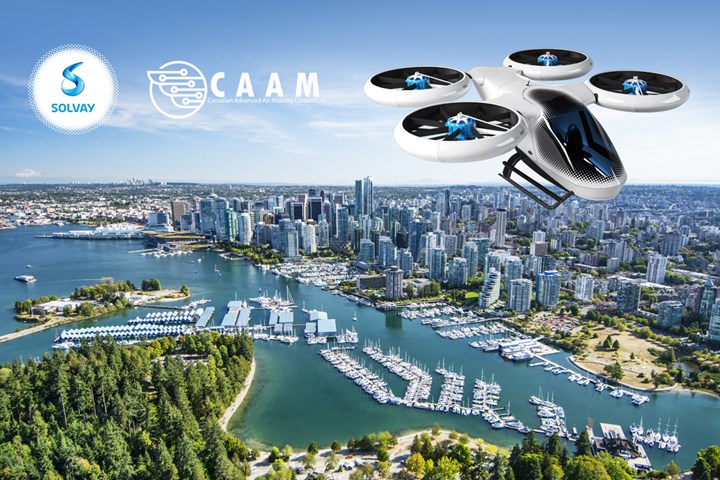Solvay joins the Canadian Advanced Air Mobility Consortium
Solvay supports Canada in its early adoption of advanced air mobility and CAAM’s 2040 long-term goal that one in five aircraft operating in Canada are emission-free.

Photo Credit: Solvay
As of April 26, Solvay (Alpharetta, Ga., U.S.) joins the Canadian Advanced Air Mobility Consortium (CAAM) launched in October 2020, alongside key business partners and other global urban air mobility (UAM) players, to develop the future of transportation in Canada.
UAM will play a pivotal role in the future of aviation, Solvay says, and by joining CAAM, the company will share knowledge and develop a technology roadmap to help build an ecosystem of national collaboration towards a sustainable, equitable and profitable UAM industry within Canada.
Solvay notes that, by 2024, it is anticipated that electric passenger UAM aircrafts will be a reality and that Canada may be an early adopter of this new way of transport, due to its geography of dense cities and remote rural areas.
Local governments recognize the unique needs of their communities, but in order to make the UAM ecosystem a reality they need collaboration from industry experts and researchers to manage public acceptance and implementation, Solvay says. With the support of it and other members, CAAM’s 2040 long-term goal is to ensure that one in five aircraft operating throughout Canada will be emission-free.
As part of its membership to CAAM, Solvay is excited to drive the “Next-Generation Manufacturing” effort and support the industry’s ambition to move people and goods throughout communities, while reducing congestion on the ground for future generations.
Related Content
-
Low-cost, efficient CFRP anisogrid lattice structures
CIRA uses patented parallel winding, dry fiber, silicone tooling and resin infusion to cut labor for lightweight, heavily loaded space applications.
-
First Airbus A350 crash confirmed in Haneda
Shortly after touch-down, a JAL A350-900 aircraft recently collided with a De Havilland Canada Dash 8. Exact circumstances are still unknown.
-
Plant tour: Airbus, Illescas, Spain
Airbus’ Illescas facility, featuring highly automated composites processes for the A350 lower wing cover and one-piece Section 19 fuselage barrels, works toward production ramp-ups and next-generation aircraft.






